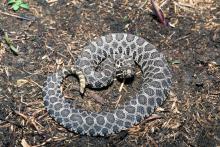Reptiles and Amphibians
Media

Species Types
Scientific Name
Ambystoma annulatum
Description
The ringed salamander is secretive, spending most of its time under logs or rocks or in burrows. The rings never completely encircle the body. It occurs in the southwestern and central Missouri Ozarks, and in the river hills of the Missouri River in eastern Missouri.
Media

Species Types
Scientific Name
Pantherophis ramspotti
Description
The western foxsnake is a moderately large snake with distinct brown blotches. In Missouri, it is rare and found only in our far northwestern counties.
Species Types
Scientific Name
Pantherophis vulpinus
Description
The eastern foxsnake is extremely similar to the western foxsnake and is mainly identified by its different geographic distribution: in Missouri, this rare species is found only in a few counties along the Mississippi River floodplain north from St. Louis.
Media

Species Types
Scientific Name
Agkistrodon piscivorus
Description
The cottonmouth is named for the cotton-white lining of its mouth, which it opens widely when alarmed. This dangerously venomous, semiaquatic snake occurs in the southeastern corner of Missouri, with a spotty distribution in the Ozark Region.
Media

Species Types
Scientific Name
Sistrurus tergeminus tergeminus
Description
The prairie massasauga is a medium-sized rattlesnake associated with bottomland prairie habitats in north-central and northwestern Missouri. This endangered species is shy, reclusive, and nonaggressive.
Media

Species Types
Scientific Name
Nerodia fasciata confluens
Description
The broad-banded watersnake is a semiaquatic snake with broad, irregularly shaped bands that can be brown, reddish brown, or black and are separated by yellow or gray. This nonvenomous species is restricted to the southeastern corner of the state.
Media

Species Types
Scientific Name
Nerodia rhombifer rhombifer
Description
The northern diamond-backed watersnake is our largest watersnake. It has numerous diamond-shaped light markings along the back. It occurs in the Bootheel and north along the Mississippi River, and in much of northern and western Missouri. It doesn’t occur in the Ozarks or in much of central-eastern Missouri.
Media

Species Types
Scientific Name
Trachemys scripta elegans
Description
The red-eared slider is an attractive aquatic turtle with yellow pinstripes and red ears. It is commonly seen basking on logs or rocks and occurs statewide, except for a few northern counties.
Media

Species Types
Scientific Name
Siren intermedia nettingi
Description
The western lesser siren is an eel-like, aquatic salamander with external gills, small eyes, small forelimbs with four toes, and no hind limbs. In Missouri, it’s found mostly in the Bootheel and northward in counties near the Mississippi River.
Media

Species Types
Scientific Name
Coluber constrictor flaviventris (eastern yellow-bellied racer) and Coluber constrictor priapus (southern black racer)
Description
The eastern yellow-bellied racer is uniformly tan, brown, olive, blue, gray, or nearly black on top, with a yellow, cream, or light blue-gray belly. It occurs nearly statewide. The southern black racer subspecies also lives in the southeastern half of the state.
See Also
About Reptiles and Amphibians in Missouri
Missouri’s herptiles comprise 43 amphibians and 75 reptiles. Amphibians, including salamanders, toads, and frogs, are vertebrate animals that spend at least part of their life cycle in water. They usually have moist skin, lack scales or claws, and are ectothermal (cold-blooded), so they do not produce their own body heat the way birds and mammals do. Reptiles, including turtles, lizards, and snakes, are also vertebrates, and most are ectothermal, but unlike amphibians, reptiles have dry skin with scales, the ones with legs have claws, and they do not have to live part of their lives in water.





















